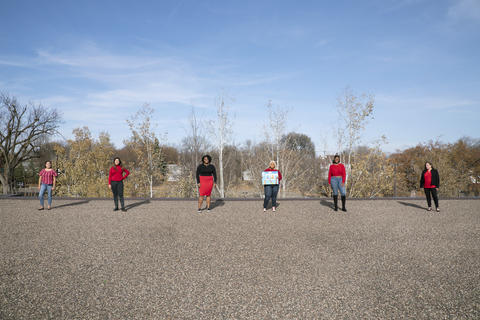
Celebrating Together

When Minneapolis photographer Sarah Sampedro wrote the proposal that won her the job of creating portraits honoring the first ten years of UROC’s research-based partnerships with community members, she envisioned photos of participants interacting at Northside coffee shops and other local gathering places. But everything changed when COVID-19 swept the world, forcing Sampedro to completely reimagine how to visually convey strong, long-lasting community engagement
“The whole project was about working together, and about relationships that have developed over the last ten years between University participants and community partners,” she recalls. “Suddenly, distance was more important than togetherness, and we all needed to be at least six feet apart and outside, which we thought was safer. Everyone was still technically together, but in a different way, a way that in many respects embodies the simplicity of our lives now during the pandemic.”
Working closely with UROC Executive Office Administration Specialist Johneva Davis, Sampedro, who has an MFA from the University of Minnesota, thought not only about how best to conduct socially distanced photo shoots. She also spent time learning about UROC and the ten community partners to be featured in the portraits, which will be on display in UROC’s website this June and in its gallery when the facility reopens.
Visualizing Community Partnerships
The exhibit, named “Together,” is part of UROC’s tenth-year anniversary celebration, and it will replace portraits taken of community partners when the center first opened. “I’m so happy to have been a part of this project,” says Davis, who served as coordinator. “We really want to show that we are still standing strong in the community and, even during these hard times, we are still together and working with our partners.”
Putting people at ease to get their pictures taken during a pandemic sounds nearly impossible, but Davis saw right away that Sampedro, who lives just a few blocks from UROC, seemed to know intuitively what to do. “I’m used to seeing photographers tell people where they should be and how things will go, but Sarah gave people time to talk to each other so she could see them in their natural state,” Davis recalls, explaining that they also played music to make things more fun.
“Everyone was so happy, and sometimes we even had dance parties,” Davis continues. “Once everyone had settled into the moment, Sarah would start taking pictures, so she really captured people being themselves.”
UROC staff considered nearly 100 partnerships before selecting the ten that would be featured in the photo exhibit, which will be unveiled later this year in time for the research center’s annual Community Day Celebration set for Monday, June 21, 2021.
While most photos were of just two people, one from the University and the other from the community, others included several members of a community partnership team so Davis and Sampedro were careful to choose locations where everyone could spread out. Masks were removed only briefly when the photos were taken, and caddies with gloves, hand sanitizer and extra masks were always at the ready.
Setups for the photos were simple and featured only one object, something participants felt was representative of their partnership. One of Sampedro’s favorite shots featured University of Minnesota Extension Educator Karl Hakanson and Michael Chaney, director of Project Sweetie Pie.
The two of them brought a hoe and a rake, symbolizing their partnership’s focus on urban gardening and food security. “Chaney was wearing a straw farmer’s hat and a boxing robe to symbolize his fight for nature and the Earth, which brought it all together in a wonderful, personal way,” she recalls.
In another portrait, former UROC Gallery Curator Hawona Sullivan-Janzen posed with Christopheraaron Deanes of the Roho Collective, a Twin Cities network for artists of color. Beside them was a painting by Deanes called “Mother Earth,” which he described as “speaking to the gathering, caring and sharing of the community through a creative lens.”
Though the project took much longer than she had originally intended due to the pandemic, Sampedro enjoyed the experience and is happy with the results. “People would always talk about how busy they were when we got together to take a photo but, every time, people lingered just to spend time with each other, even if it was in the parking lot. They just wanted to be in a space together, and I found that so wonderful.”